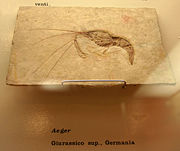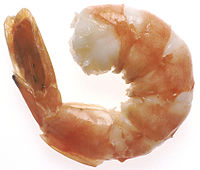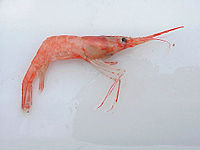
Caridea
Did you know...
SOS Children has tried to make Wikipedia content more accessible by this schools selection. SOS Children is the world's largest charity giving orphaned and abandoned children the chance of family life.
| Shrimp | |
|---|---|
 |
|
| Scientific classification | |
| Kingdom: | Animalia |
| Phylum: | Arthropoda |
| Subphylum: | Crustacea |
| Class: | Malacostraca |
| Order: | Decapoda |
| Suborder: | Pleocyemata |
| Infraorder: | Caridea Dana, 1852 |
| Superfamilies | |
|
Alpheoidea |
|
True shrimp are swimming, decapod crustaceans classified in the infraorder Caridea, found widely around the world in both fresh and salt water. Together with prawns, they are widely caught and farmed for human consumption.
Taxonomy
A number of more or less unrelated crustaceans share the word "shrimp" in their common name. Examples are the mantis shrimp and the opossum or mysid shrimp, both of which belong to the same class ( Malacostraca) as the true shrimp, but constitute two different orders within it, the Stomatopoda and the Mysidacea. Triops longicaudatus and Triops cancriformis are also popular animals in freshwater aquaria, and are often called shrimp, although they belong instead to the Notostraca, a quite unrelated group.
Shrimp are distinguished from the superficially similar prawns by the structure of the gills, There is, however, much confusion between the two, especially among non-specialists, and many shrimp are called "prawns" and many prawns are called "shrimp". This is particularly widespread in culinary contexts. In Southeast Asia, the difference between shrimp and prawns is based on size, with larger shrimp being called prawns.
Shrimp as food
Wikibooks Cookbook has a recipe/module on
|
Recipes using shrimp form part of the cuisine of many cultures: examples include shrimp kebabs, shrimp creole, shrimp gumbo, pan fried, deep fried, stir fried. Strictly speaking, dishes containing scampi should be made from the Norway lobster, a shrimp-like crustacean more closely related to the lobster than shrimp, but in some places it is quite common for large shrimp to be used instead.
As with other seafood, shrimp is high in calcium and protein but low in food energy. A shrimp-based meal is also a significant source of cholesterol, from 7 mg to 251 mg per 100 g of shrimp, depending on the method of preparation.
Dried shrimp is commonly used as a flavoring and as a soup base in Asian cuisines while fried shrimp is popular in North America. In Europe, shrimp is very popular, forming a necessary ingredient in Spanish paella de marisco, French bouillabaisse, Italian cacciucco, Portuguese caldeirada and many other seafood dishes. Shrimp curry is very popular in South Asia and Southeast Asia. They are also found in Latin and Caribbean dishes such as enchiladas.
Shrimp and other shellfish are among the most common food allergens. Also, eating shrimp - either dried or fresh - may lead to iodine poisoning.
Distinction from prawns
While in biological terms prawns are of a distinct biological suborder of Decapoda, in commercial farming and fishery the terms shrimp and prawn are often used interchangeably. In European countries, particularly the United Kingdom, the word “prawns” is more commonly on menus than the term “shrimp”, which is used more often in North America. The term “prawn” is also loosely used to describe any large shrimp, especially those that come 15 (or fewer) to the pound (also called “jumbo shrimp”). Australia and other Commonwealth countries follow this European/British use to an even greater extent, using the word “prawn” almost exclusively. Paul Hogan’s use of the phrase “I'll slip an extra shrimp on the barbie for you” in a television advertisement was intended to make what he was saying easier for his American audience to understand, and was thus a deliberate distortion of what an Australian would typically say.
Preparation
Preparing shrimp for consumption usually involves removing the shell, tail, and "sand vein".
To deshell a shrimp, the tail is held while gently removing the shell around the body. The tail can be detached completely at this point, or left attached for presentation purposes.
Removing the "vein" (a euphemism for the digestive tract) can be referred to as " deveining", though in fact shrimp do not have any real veins; they have an open circulatory system. The "vein" can be removed by making a shallow cut lengthwise down the outer curve of the shrimp's body, allowing the dark ribbon-like digestive tract to be removed with a pointed utensil. Alternatively, if the tail has been detached, the vein can be pinched at the tail end and pulled out completely with the fingers.
The shrimp is then rinsed under cold running water.
Shrimp in aquaria
Several types of shrimp are kept in home aquaria. Some are purely ornamental, while others are useful in controlling algae and removing debris. Freshwater shrimp commonly available for aquaria include the Japanese marsh shrimp (Caridina multidentata , also called "Amano shrimp," as their use in aquaria was pioneered by Takashi Amano), cherry shrimp (Neocaridina heteropoda), and ghost or glass shrimp ( Palaemonetes spp.). Popular saltwater shrimp include the cleaner shrimp Lysmata amboinensis, the fire shrimp (Lysmata debelius) and the harlequin shrimp (Hymenocera picta).



